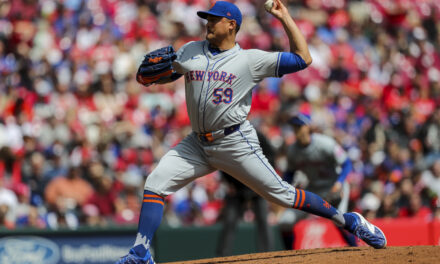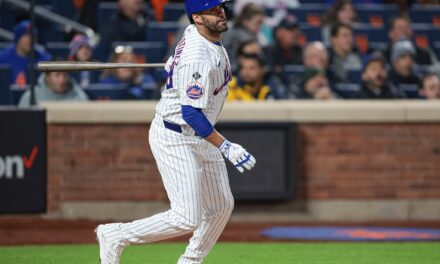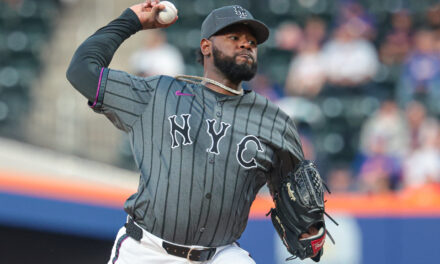
If you looked at Amed Rosario’s numbers purely on the surface, you wouldn’t think that he is a potential star in the making. But dig deeper into his stats, and you’ll find reason to believe that the talented 23-year-old shortstop will blossom into the dynamic five-tool superstar that we all thought he could become.
Rosario only batted .256/.295/.381 with 24 stolen bases in 2018, but his production spiked significantly in August and September. Rosario strengthened his production in all areas, as he began hitting the ball with more authority and stealing bases more frequently and efficiently. This resulted in an improved .284/.318 OBP/.413 triple slash line in the season’s final two months to go along with 15 steals in 20 attempts.
Obviously, two solid months of production isn’t enough evidence to say that Rosario truly turned the corner. Being Mets’ fans, we’ve seen even former busts, such as Ike Davis and Lastings Milledge, sprinkle in a few stretches of good production here and there. But what makes me so confident that Rosario will not disappoint is the significant amount of growth that he’s displayed since his debut.
Rosario’s biggest weakness, his plate discipline, has steadily improved. While he will never be an on base machine like Brandon Nimmo, the numbers show that Rosario is being more selective at the plate with his walk rate increasing and strikeout rate decreasing:
- 2017: 1.8 BB%, 28K%
- 2018: 4.9 BB%, 20K%
Part of this improvement is the result of Rosario laying off more pitches outside the zone. According to Pitch Info on Fangraphs, Rosario swung at 48.1% pitches outside the zone in 2017, but he cut this number down to 41.2% in 2018.
While this rate is still very high, the almost seven point improvement is evidence that he is trending in the right direction. Additionally, he swung at 67 % of pitches inside the zone, up three percent from 2017.
This is a key factor because it means that Rosario isn’t increasing his walk rate by merely taking more pitches and being passive. He’s identifying better pitches to attack, and he is learning which ones to take. If he can make more strides like this in 2019, then he will easily increase his OBP to the point where it is no longer a liability in the lineup.

And given his quick hands and excellent bat speed, Rosario is simply too talented for his batting average to remain as low as .256. Analysts like Keith Law, have always raved about Rosario’s ability to hit for hard contact, and many experts salivated at the thought of his plus bat speed leading to more power down the road.
While this power has yet to materialize, Rosario impressed all the prospect gurus in the minors by rocketing line drives all over the field. In his last three minor league seasons, Rosario batted over .300 every year, including an impressive high of .341 in Double-A. He also batted .328 in Triple-A before getting called up to the majors.
Furthermore, it’s possible that poor BABIP luck hindered Rosario’s average in 2018. His .310 BABIP may seem high, but it’s the lowest it’s ever been since his rookie ball season in 2013. For reference, here is his BABIP over the previous two seasons:
- 2017 (Majors) .330 BABIP
- 2017 (Triple-A) .377 BABIP
- 2016 (Double-A) .433 BABIP
- 2016 (Single-A) .345 BABIP
A BABIP more in line with his 2017 number of .330 seems attainable given his history of always producing a higher than average BABIP. This would create an uptick in batting average, which would also increase his OBP.
A better average combined with improving plate discipline would enable Rosario to thrive in a leadoff role. Rosario, measured as the MLB’s 27th fastest player last year by Statcast, figures to be a prolific baserunner.
His 15 stolen bases over the season’s final two months would put him on a pace of 46 in a full season. His stolen base percentage is also improving as he becomes more experienced:
- Rosario’s first 25 attempts: SB% 64
- Rosario’s last 20 attempts: SB% 75
Defensively, Rosario did not play up to his ability in 2018 committing 16 errors and posting a – 5.2 Ultimate Zone Rating. But I suspect that these struggles have more to do with inexperience rather than lack of ability.
By all expert accounts from the minors, Rosario is a gifted and skilled defender. John Sickels of Minor Leagueball.com once wrote that “[he’s] got the range, hands, and arm strength to be an above-average-to-excellent defender at shortstop. That’s been known for years. …”
One would think that such tremendous athlete like Rosario will soon put it all together on defense, making him a potential star in both the field and at the plate.
Some will dislike my idea of putting a player that has struggled so much with his plate discipline in the leadoff spot, but my argument is that he should only be put there if he steps forward this season and shows continued improvement.
And if some critics still doubt that a player like Rosario could one day succeeded as a leadoff hitter, I will give you this comparison:
- Player A: Age 22, .273 BA, .300 OBP and 1.7 WAR
- Rosario: Age 22, .256 BA, .295 OBP and 1.5 WAR
Player A is Jose Reyes, the most exciting and dynamic leadoff man the Mets ever had. The similarities are uncanny given that both play the same position, had similar struggles at the same age with nearly identical WAR’s.
I’m expecting Rosario to produce a Jose Reyes-esque breakthrough in 2019. It will be the year when Rosario finally unleashes his massive potential and emerges as one of the premier shortstops in the game.















